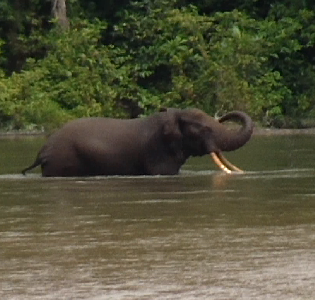Dateline: 23 April – Port Gentil
She had a real presence. You could feel her command as head of the household but very much a mother as well. Her mostly grey hair was straight, short, and swept back giving a hint of the leonine, and smallish straight teeth that flashed with her frequent smiles and dimpled cheek.
We were somewhere on the edges of Port Gentil (‘pour jauntee’) visiting the family of a friend of Ghislain, the new acoustics intern that I am training. The friend is in university in England but clearly Ghislain was special to the whole family. The ‘establishment’ was very much in process, with some rooms finished, but we sat in a large unfinished (mostly unroofed) area that was to become a restaurant I think. Smelled of fresh concrete – block walls without doors but the holes framed in. A wide shuttered window let onto what would be the kitchen area and seeming a bit maze-like, multiple unfinished walls running off into the dimness out one door opening.
Someone went out for a beer for me and Ghislain and he chatted about whatever, including a bit about his recent experiences in Loango with me. It was very pleasant even without understanding more than 60% of what was said. It is fun to listen to the cadences of conversation and the way that Gabonese, especially men it seems, give a sort of high exclamation of emphasis or surprised response.
We were there for quite some time and with only something for breakfast the beer had maximum relaxing effect on me. We waited for another friend, America, who, in the end, never arrived. Eventually we left to meet him elsewhere. This accomplished, we went to a bar for another beer. Gabonese seem intent on many repeat drinks, which I was not interested in. But another Regab happened and I was thinking about the fashionably late dining typical in French-influenced societies.
Amazingly, a man who used to tend bar at the Loango Lodge (one of the only tourist destinations in Gabon – at the north end of Loango National Park) a couple of years ago came over to say ‘hello’ – I guess I was an easy one to recognize. I sort of thought he was soliciting something, certainly I did not recognize him until he said something to Ghislain about knowing me and from where, then I did recall his face.
Yet another friend of Ghislain joined us (this was going to repeat everywhere we went on this trip) and we were at the bar for another hour or so. Finally we left to get something to eat at America’s house. The second friend had a car and we started out with him. He spoke English quite well and asked if I liked Gabonese women and that he had a sort of ‘business’. Too bad for him I am so boring! He dropped us off in a rather abandoned-looking part of the city and we snaked our way back through an empty lot to America’s house. His lovely wife welcomed us in and set us down in a small cozy sitting area mostly filled with chairs and sofas around all walls with a coffee table in center and an entertainment system on one wall. Traditional music played.
A couple more Regabs showed up and I suggested America and I share one. Again fun conversation mostly to listen to, some talk of music and the languages of Gabon and whether we have dialects in the U.S. Finally we had a lovely dinner with a much appreciated salad to start (in the last week I had not seen much green except from a can). Brise, a friend of America’s, joined us for dinner. He was learning English for his job so we talked some about music and his aspirations for the future.
By now it was 11:30 pm and I was long past ready to go to bed. That was not to be. We threaded our way again to the road and took a taxi to the center of Port Gentil to a night club, of all places. It was a place for ‘young women’, I was told as we went in. Mirrored walls, strobe lights and disco-ball, raised platforms with poles – OMG. Not many clients and these mostly middle-aged (and older) white males. Every second song or so, four or five young Gabonese women come out to dance, one typically gyrating suggestively on a raised platform with a pole. After a few minutes, presumably because of lack of response from the clientele, they stop and sit down to sip their drinks.
We ordered drinks – a coke for me, beers and a scotch for the others. The tab was $35! My coke was $8. What a waste. I don’t know how much this venue was for me. Brise, the friend at dinner, urged me to dance: ‘one of the women will immediately join you. They like white men because you have money.’ Well, I don’t and have no interest anyway. Finally, after forty minutes or so, we left and Ghislain and I took a taxi to the hotel.
As soon as we walked into the room Ghislain turned on the TV and started ethnic music playing again from his laptop (I didn’t realize this until much, much later). By the time I brushed my teeth Ghislain was asleep next to the laptop. I turned off the TV and the lights and wondered how long I would have to ignore the music before it ended for the night. I couldn’t sleep with the music and finally, who knows when, I went into the bathroom and realized the music was not outside but right there next to Ghislain! But by now it was nearly 4am and we had to get up at 5:30 to go to the airport.
So much for a night in Port Gentil.















